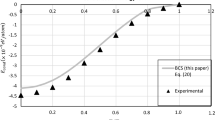Abstract
A study is made of the thermodynamic properties of a three-band superconductor with an electron (or hole) mechanism of superconductivity. Interband carrier interaction is considered as the main reason for the occurrence of superconducting pairs. Expressions are obtained for the order parameters Δ n (T) (n=1, 2, 3), the specific heatC S, and the thermodynamic critical fieldH c in the region of low temperatures and also the temperatureT c of the superconducting transition, the jump in the specific heat (C S−CN) at the pointT=T c; and 2Δ n (0)/T c . It is shown that a characteristic feature in the behavior ofT c, (C S−CN), and Δ n (0) as functions of the carrier concentrationn is the presence of a smeared step. It is also shown that (C S−CN)/C N≤1.43 and that this ratio depends strongly on the relationship between the densities of the electron states of the considered bands.
Similar content being viewed by others
References
J. Bardeen, L. N. Cooper, and J. P. Schrieffer,Phys. Rev.,106, 162 (1957).
N. N. Bogolyubov, D. N. Zubarev, and Yu. A. Tserkovnikov,Dokl. Akad. Nauk SSSR,117, 778 (1957).
N. N. Bogolyubov,Zh. Eksp. Teor. Fiz.,34, 58, 75 (1958).
N. N. Bogolyubov, V. V. Tolmachev, and D. V. Shirkov,A New Method in the Theory of Superconductivity, New York (1955).
T. M. Éliashberg,Zh. Eksp. Teor. Fiz.,38, 960 (1960).
A. S. Aleksandrov,Pis'ma Zh. Eksp. Teor. Fiz.,46, 128 (Appendix) (1987).
J. E. Hirsh and F. Marsiglio,Phys. Rev. B,39, 115 (1989).
P. W. Anderson,Science,235, 1196 (1987).
Yu. V. Kopaev,Usp. Fiz. Nauk,159, 567 (1989).
D. H. Lee and I. Ihm,Solid State Commun.,62, 811 (1987).
V. A. Moskalenko, M. E. Palistrant, and V. M. Vakalyuk, in:Mechanisms of High-Temperature Superconductivity [in Russian], JINR, Dubna (1988), p. 34.
V. A. Moskalenko, M. E. Palistrant, and V. M. Vakalyuk,Fiz. Nizk. Temp.,15, 378 (1989).
V. A. Moscalenko, M. E. Palistrant, V. M. Vackalyuk, and I. V. Padure,Solid State Commun.,69, 747 (1989).
V. P. Galaiko, E. V. Bezuglyi, and V. S. Shumeiko,Fiz. Nizk. Temp.,13, 1301 (1987).
P. Konsin, N. Kristoffel, and T. Ord,Phys. Lett. A,129, 339 (1988).
M. E. Palistrant and V. M. Vakalyuk, in:Superconductivity: F.Kh.T., Vol. 3, No. 8, Part 2 [in Russian] (1990), p. 1805.
V. A. Moskalenko, M. E. Palistrant, and V. M. Vacalyuk, in:Tenth International Symposium on the Jahn—Teller Effect, Kishinev (1989), p. 88.
M. E. Palistrant and V. M. Vackalyuk,Ibid. Tenth International Symposium on the Jahn—Teller Effect, Kishinev (1989), p. 88.
M. E. Palistrant and F. G. Kochorbe, in:Proceedings of Third All-Union Symposium on High-Temperature Superconductivity [in Russian], Khar'kov (1991), p. 108.
M. Oda, T. Ohguro, et al.,J. Phys. Soc. Jpn.,58, 1117 (1989).
W. E. Farneth, R. K. Bordia, et al.,Solid State Commun.,66, 953 (1988).
V. A. Moskalenko, M. R. Palistrant, and V. M. Vakalyuk,Usp. Fiz. Nauk, 161, No. 7 (1991).
L. F. Mattheis and D. R. Hamman,Solid State Commun.,63, 395 (1987).
L. F. Mattheis,Phys. Rev. Lett.,58, 1028 (1987).
H. Krakauer and W. E. Pickett,Phys. Rev. Lett.,60, 1665 (1988).
M. S. Hybertsen and L. F. Mattheis,Phys. Rev. Lett.,60, 1661 (1988).
J. F. Herman, R. V. Kasowski, and W. I. Hsu,Phys. Rev. B,36, 6904 (1987).
V. A. Moskalenko,Fiz. Met. Metalloved.,8, 504 (1959).
V. A. Moskalenko and M. E. Palistrant, in:Statistical Physics and Quantum Field Theory [in Russian], Nauka, Moscow (1973), p. 262.
V. A. Moskalenko,Electromagnetic and Kinetic Properties of Superconducting Alloys with Overlapping Energy Bands [in Russian], Shtiintsa, Kishinev (1976).
V. A. Moskalenko, L. Z. Kon, and M. E. Palistrant,Low-Temperature Properties of Metals with Special Band Spectrum [in Russian], Shtiintsa, Kishinev (1989), p. 282.
I. Hongshun, Z. Xiaonong, et al.,Physica (Utrecht) C,172, 71 (1990).
E. G. Volovik,Pis'ma Zh. Eksp. Teor. Fiz.,49, 685 (1989).
A. Junod, D. Efkert, et al.,Physica (Utrecht) C,159, 215 (1989).
Additional information
Institute of Applied Physics, Moldavian Republic Academy of Sciences. Translated from Teoreticheskaya i Matematicheskaya Fizika, Vol. 91, No. 3, pp. 483–499, June, 1992.
Rights and permissions
About this article
Cite this article
Kalalb, M.G., Kochorbe, F.G. & Palistrant, M.E. Superconductivity based on a model with three overlapping energy bands and a nonphonon mechanism. Theor Math Phys 91, 664–676 (1992). https://doi.org/10.1007/BF01017344
Received:
Issue Date:
DOI: https://doi.org/10.1007/BF01017344




